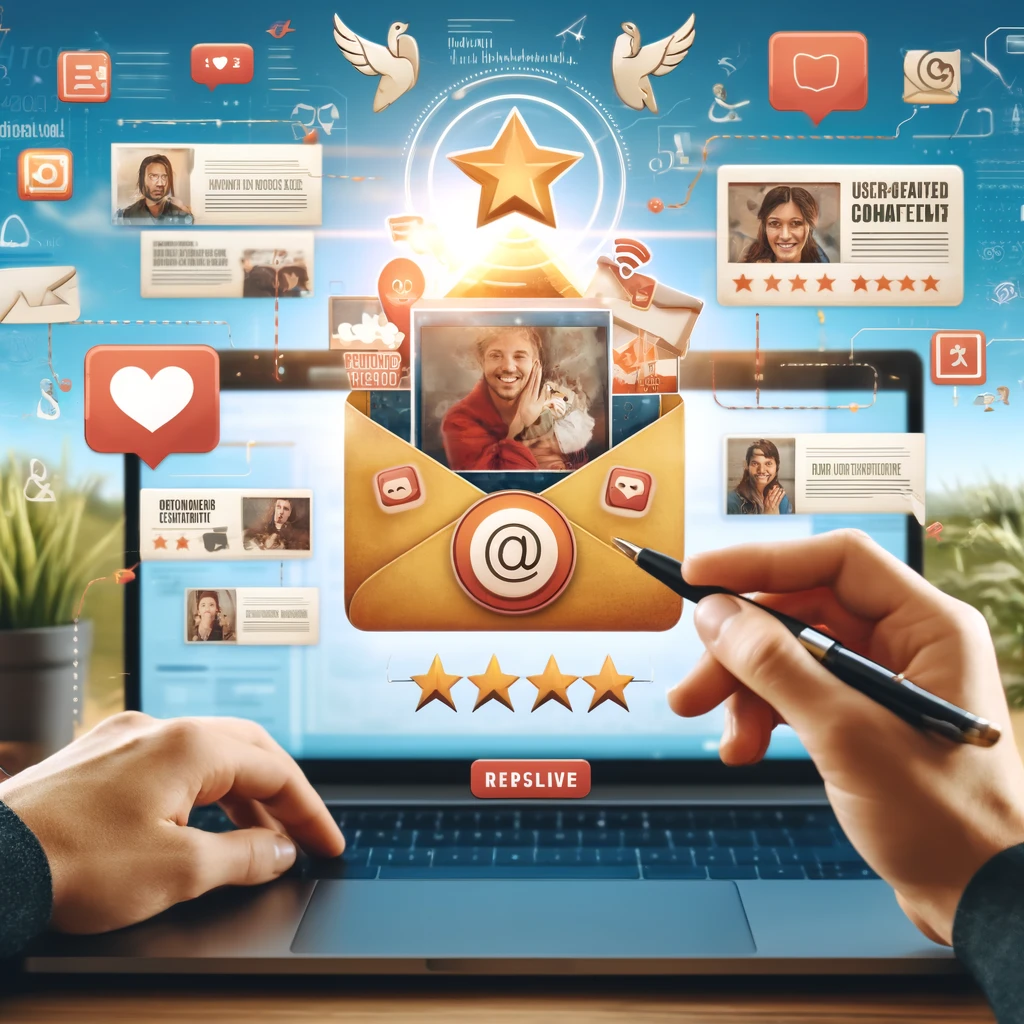User-Generated Content in Email Marketing has become a powerful tool in digital marketing, particularly in email campaigns. This content, created by customers and shared with the brand, can include reviews, photos, videos, and social media posts. Incorporating User-Generated Content in Email Marketing not only enhances the authenticity of the message but also helps establish trust with the audience. When done correctly, User-Generated Content in Email Marketing increases engagement, boosts conversions, and builds stronger customer relationships. This article explores the importance of User-Generated Content in Email Marketing, how to effectively integrate it into campaigns, and how to measure its success to refine future strategies.
What is User-Generated Content in Email Marketing and Why It Works

User-Generated Content in Email Marketing refers to any content created by customers or users of a brand rather than the brand itself. This can include reviews, photos, videos, testimonials, social media posts, and even blog comments. User-Generated Content in Email Marketing builds trust and authenticity, enhances engagement, and helps foster deeper connections between a brand and its customers.
The Psychological Impact of User-Generated Content in Email Marketing
User-Generated Content in Email Marketing works exceptionally well due to its psychological impact on consumers. First and foremost, it acts as a form of social proof. When potential customers see others engaging with your brand, they feel more confident in their decision to make a purchase. People trust the opinions of fellow consumers more than traditional advertising, especially when User-Generated Content in Email Marketing provides real-life examples of your products or services being used. A review or photo of a product being used by a customer is often more convincing than a glossy ad produced by the brand itself.
Additionally, User-Generated Content in Email Marketing makes a brand feel more authentic. Emails featuring real customer stories or photos feel less promotional and more genuine, offering a sense of human connection. This authenticity is key to building trust, as customers are more likely to engage with User-Generated Content in Email Marketing that feels relatable and honest.
The sense of belonging also plays a crucial role. User-Generated Content in Email Marketing creates a community around a brand, where customers feel like they are part of something larger than just a transaction. By showcasing content from actual users, brands allow their audience to see themselves reflected in the brand’s narrative, strengthening emotional ties.
How User-Generated Content in Email Marketing Enhances Engagement and Builds Stronger Customer Relationships
In email marketing, User-Generated Content in Email Marketing can significantly enhance engagement and foster stronger relationships with customers. When brands feature User-Generated Content in Email Marketing, they make customers feel seen and appreciated, which encourages further interaction. Including a customer’s photo or review in an email is a great way to show recognition, which, in turn, can lead to more positive interactions.
For example, when an e-commerce brand shares user-submitted photos of customers wearing their products, it not only highlights the product in use but also makes the customer feel valued. This encourages others to engage with the brand as well, either by submitting their own content or by purchasing the featured product. Additionally, emails with User-Generated Content in Email Marketing tend to have higher open rates and click-through rates because they resonate more with recipients, providing them with relevant and relatable content.
Another benefit of User-Generated Content in Email Marketing is its ability to humanize a brand. By showcasing real customers, brands appear more approachable and relatable, making the brand seem like it is actively engaging with its audience rather than just selling to them. This personal touch can deepen customer loyalty and lead to long-term relationships.
In summary, User-Generated Content in Email Marketing is a powerful tool. It helps build trust, creates authenticity, and provides social proof. By leveraging User-Generated Content in Email Marketing, brands can enhance engagement, create stronger emotional connections, and ultimately build a more loyal customer base. Incorporating User-Generated Content in Email Marketing into email campaigns transforms them from promotional messages to interactive, community-driven experiences
Effective Ways to Incorporate UGC into Your Email Campaigns

User-Generated Content (UGC) is an incredibly valuable tool for email marketing, but knowing how to incorporate it effectively into your campaigns is key to reaping the full benefits. Whether you are showcasing customer reviews, photos, videos, or encouraging submissions through contests and social media, UGC can bring a sense of authenticity and relatability to your emails that resonates with recipients. Below are a few effective ways to incorporate UGC into your email marketing efforts.
1. Showcasing Customer Reviews, Photos, and Videos in Email Designs
One of the simplest yet most powerful ways to incorporate UGC into your emails is by including customer reviews, photos, and videos directly in your email designs. Positive reviews serve as powerful social proof, convincing potential customers to take the next step in their buyer’s journey. When showcasing customer reviews, it’s important to include the name, photo (if possible), and the specific product or service the customer used to make the review feel more personal and authentic.
In addition to reviews, photos and videos submitted by customers can bring even more impact to your email. If a customer shares an image of themselves using your product, featuring that in your email shows that real people are enjoying your brand. Visual content in emails tends to increase engagement and conversions, so be sure to optimize these images for email (make them mobile-friendly and of high quality).
A simple yet effective approach would be to feature a testimonial carousel that highlights different customers’ experiences. Videos, such as unboxing or product review videos, can also be included in email campaigns. Embedding a thumbnail image that links to a YouTube video or a landing page with the video works best to avoid file size issues in emails.
2. Encouraging Customers to Submit Content Through Contests, Surveys, or Social Media
Engaging your customers and encouraging them to submit content is a great way to fuel your UGC strategy. Running contests or surveys offers an incentive for customers to share their experiences with your brand. For example, you could ask customers to submit photos or stories of how they use your product in exchange for a chance to win a prize or receive a discount. This not only creates a sense of involvement but also provides you with fresh content that you can use in future campaigns.
Social media platforms are another great way to gather UGC. Encourage your customers to share their photos, reviews, or experiences on social media using a specific hashtag. Then, feature the best submissions in your email campaigns. This approach creates a community around your brand and also encourages customers to engage more with your brand on social media.
You can also integrate a call-to-action in your emails, prompting customers to submit content. For example, a simple line like “Share your experience with us on Instagram using #BrandHashtag for a chance to be featured in our next email” can drive engagement and inspire submissions.
3. Best Practices for Curating UGC and Integrating It Seamlessly Into Email Templates
Once you’ve gathered your UGC, the next step is to curate and integrate it seamlessly into your email campaigns. It’s important to ensure that the content aligns with your brand’s message and tone. Avoid overwhelming your recipients with too many images or lengthy reviews. Instead, carefully select the most relevant and impactful content that supports your campaign’s objective.
A key best practice is to use responsive email templates that display the UGC beautifully across devices, especially mobile, where most users access emails. Whether it’s a photo, a review, or a video, ensure the content is properly optimized to load quickly and display well on all screen sizes.
Additionally, consider segmenting your email lists to send personalized UGC to specific audiences. For example, you could send tailored content featuring customer photos of a specific product to those who have already purchased it, or showcase reviews from customers who live in a similar area.
Finally, remember to credit the original content creators. Always give recognition to the customers who contributed, either by tagging them on social media or including their names in the email. This adds an extra layer of authenticity and makes the customer feel valued.
Incorporating UGC into your email campaigns can greatly increase engagement, build trust, and strengthen your relationship with customers. By showcasing real customer experiences, encouraging new submissions, and following best practices for integration, you can leverage UGC effectively and create more impactful email marketing campaigns.
Measuring the Success of UGC in Email Marketing Campaigns

When integrating User-Generated Content (UGC) into email marketing campaigns, measuring its success is essential to understanding its impact on engagement, conversions, and overall business objectives. By tracking key metrics and analyzing customer feedback, you can fine-tune future campaigns and continue to improve the effectiveness of your UGC strategy. Here’s how to measure and analyze the success of UGC-driven email campaigns.
Key Metrics to Track When Using UGC in Emails
- Open Rates: The first step in measuring the success of UGC in email campaigns is tracking open rates. If your UGC is compelling enough to catch the audience’s attention, you’ll likely see a higher open rate. A subject line that includes “Featured Customer Review” or “See How Our Customers Are Using [Product]” can entice subscribers to open the email. Comparing the open rates of UGC-driven emails with regular promotional emails can help assess how effective your content is at sparking interest.
- Click-Through Rates (CTR): Once a recipient opens the email, click-through rates indicate how well the email content encourages further engagement. Including links to user-submitted content or calls-to-action (CTAs) like “See More Customer Reviews” or “Shop the Featured Product” can increase the chances of users clicking through. Monitoring CTR allows you to assess how well your UGC drives recipients to take the next step, whether it’s viewing a product page, making a purchase, or sharing their own content.
- Conversions: Ultimately, conversions are the most important metric for determining the success of your UGC strategy. Tracking how many recipients complete the desired action—such as making a purchase or signing up for a newsletter—can provide valuable insight into the effectiveness of your UGC-driven emails. Conversions can also be segmented by UGC type, like product photos, reviews, or customer stories, to understand which type of content has the most impact.
How to Analyze Customer Feedback and Responses to Improve Future UGC-Driven Campaigns
Analyzing customer feedback is crucial for refining your UGC strategy. The more feedback you collect, the better you can tailor future campaigns. Key insights can come from responses to the UGC shared in the emails, including comments on social media posts, customer reviews, or direct replies to your emails. Pay attention to the content that generates the most positive responses, as well as any negative feedback that could indicate areas for improvement.
Engage with your customers directly by including surveys or polls in your emails, asking them what kind of UGC they find most helpful. This direct feedback loop helps you understand what resonates with your audience and guides future content creation. You can also track how customer-generated content is shared on social media platforms, offering another layer of insight into how your audience engages with your brand.
Case Studies or Examples of Successful UGC Campaigns
Several brands have successfully leveraged User-Generated Content in Email Marketing campaigns. For example, Glossier, a beauty brand, frequently uses customer reviews, photos, and videos in their emails to promote their products. By showcasing real customers using their products, Glossier creates an authentic, relatable brand image. As a result, their User-Generated Content in Email Marketing campaigns have seen higher open rates, increased engagement, and boosted conversions, especially during product launches or promotional periods.
Another great example is Lush Cosmetics, which encourages customers to share photos of themselves using Lush products through social media hashtags. These photos are then featured in their email marketing campaigns. This strategy helps foster a sense of community while boosting sales, as the User-Generated Content in Email Marketing makes their emails feel personal and inviting, leading to higher customer engagement and sales.
In both cases, User-Generated Content in Email Marketing not only enhanced the brand’s credibility but also created a community-driven experience that resonated well with the target audience. Tracking metrics like open rates, CTR, and conversions allowed these brands to continually refine their email campaigns, leading to sustained success.
Conclusion
Incorporating User-Generated Content in Email Marketing campaigns provides an authentic and engaging way to connect with customers. By showcasing customer reviews, photos, and videos, brands can enhance trust and social proof, ultimately leading to increased engagement and conversions. Tracking key metrics such as open rates, click-through rates, and conversions is crucial for measuring the success of User-Generated Content in Email Marketing campaigns. Additionally, analyzing customer feedback allows businesses to continuously improve their strategies and deliver more personalized content. By effectively leveraging User-Generated Content in Email Marketing, brands can create more meaningful email campaigns that resonate with their audience and drive long-term success.

